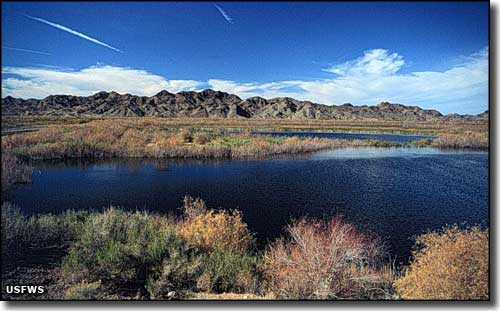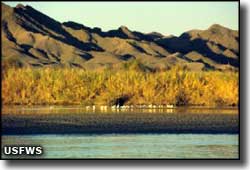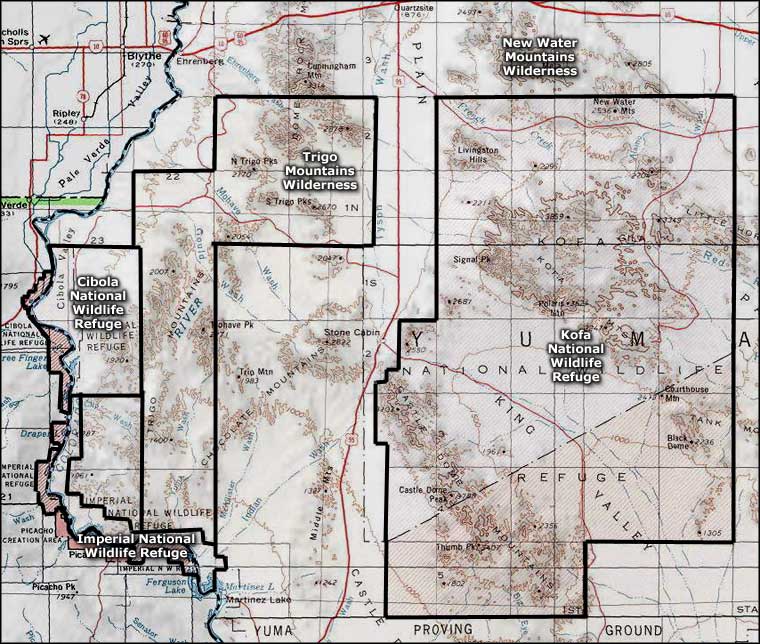
Imperial National Wildlife Refuge

The view at Mesquite Point

The Imperial National Wildlife Refuge (25,768 acres) was established in 1941 while the Wilderness Area wasn't officially designated until 1994. Imperial National Wildlife Refuge preserves and protects about 30 miles of Colorado River bottom, including the last section of unchannelized river before it enters Mexico. That makes this an incredible green oasis in the midst of a harsh and mountainous desert landscape.
The 15,000-acre Imperial National Wildlife Refuge Wilderness is split between Arizona and California with 9,220 acres in Arizona. The Wilderness is strung out along the Colorado River, upstream of the Imperial Dam. The dam caused the formation of many backwater lakes of all different sizes: from about 700 acres to as small as 1/2 acre. The Fish & Wildlife Service, with the help of many volunteers, is working to manage the marsh units, protect the backwater lakes, plant willows and cottonwood trees, farm croplands with grains for the wildlife, and restore the natural wetland habitats.
Once upon a time, the lower Colorado River was an oasis of seasonally-flooded wetlands with willows and cottonwoods in the heart of the desert. Then came human "civilizaton." In the early years, the Colorado was an important route for steamboats carrying freight and passengers. The waters were disturbed by all the traffic and many of the forests were chopped to feed the steam boilers. Then homesteaders arrived and wanted to farm the dry lands. That meant damming the river and controlling its flow. That, in turn, destroyed much of the naturalness of the habitat. Since that first dam was constructed in the early 1900's, the U.S. Fish & Wildlife Service has been working to return at least some of this countryside to its original pristine condition.
The Colorado River in this area has plenty of largemouth and striped bass but you'll have to do your fishing from a boat: the Imperial Refuge Wilderness is completely closed to public access. The nearest camping is at Picacho State Park on the California side of the river.
The Imperial National Wildlife Refuge Visitor Center is open Monday through Friday, 7:30 am to 4 pm, year round. From November 15 to March 31, the Visitor Center is open on weekends from 9 am to 4 pm. The Red Cloud Mine Road is the only scenic drive on the property, and if you want to go further than to the Painted Desert Trail, you'll want a good, high-clearance 4WD under your seat. There are lookout points at the Mesquite, Ironwood and Smoke Tree pullouts. Meers Point offers a boat launch with tables and toilets on the shore. The Painted Desert Trail is a 1.3-mile self-guided trail though an area of 30,000-year-old volcanic activity that also offers some great views over the Colorado River valley.
Special Rules and Regs:
- Wildlife observation, hiking and photography are allowed everywhere on the refuge except in the staff residence area and within the waterfowl management units.
- In the designated wilderness area, travel is by foot or horseback only.
- In some areas (and in some seasons), fishing and hunting are allowed. But you need to check with the Visitor Center for up-to-date info.
- Pets are allowed only if on a leash of 6' or less and under your control at all times.
- Boating is allowed in some areas but special regulations apply. You'll want to check with the Visitor Center before unloading your boat.
- All motorized and mechanized vehicular travel is restricted to the designated roads only. All off-road vehicle use is prohibited. Unlss otherwise posted, the speed limit is 25 mph.
- Do not damage, remove or deface anything you find on the property (except for your own trash).
- Except for legally taken game, do not disturb, molest, possess, collect, injure, destroy, remove or transport any living (or deceased) animals or plants.
- No fires and no camping allowed on the refuge.
- Legal firearms are allowed for legal hunting purposes but not for any other purpose on the property. No fireworks, no explosives, no firearms, etc.
- Same goes for bows and arrows, crossbows, air guns, etc. Bring them for approved hunting only or, better yet, don't bring them at all.

Imperial National Wildlife Refuge

Imperial National Wildlife Refuge area map
